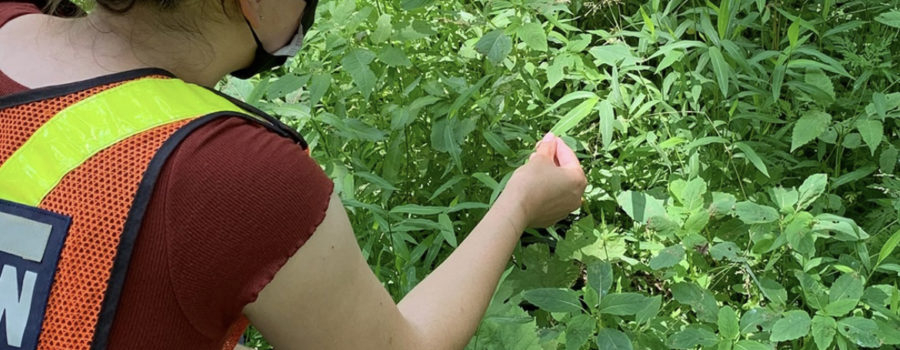Japanese stiltgrass is an invasive plant found in a variety of habitats, including forests, wetlands and disturbed areas. This plant’s prolific seed production and rapid growth helps it dominate entire habitats, edging out native vegetation. As it spreads, Japanese stiltgrass displaces nesting sites for birds and other wildlife. Economically, Japanese stiltgrass may also cost producers due to control costs and productivity losses.
Plant Pest Card – Japanese stiltgrass
Where it’s found
Japanese stiltgrass has been confirmed in a small population under official control in southern Ontario. It has not been found in any other locations in Canada. Native to Asia, this plant has been introduced into the United States and is found in Ohio, Pennsylvania and along the USAtlantic coast.
What it looks like
Japanese stiltgrass is an annual grass that sprawls across the floors of disturbed areas, forests and wetlands, as it prefers lower light. Stems can grow up to 1 m tall and have many branches. Leaf blades are thin, pale green and tapered at both ends. In late summer, slender flower spikes are found at the end of the stems. Plants develop a slightly purplish colour in autumn.
How it spreads
Japanese stiltgrass spreads when its seeds attach to clothing or animal fur. Seeds can also be found on muddy tires and footwear. Bird seed, soil, nursery stock and hay can be contaminated with Japanese stiltgrass. Once established, its seeds are naturally dispersed; it also roots from its stem nodes.
Legislation
Japanese stiltgrass is regulated as a pest in Canada under the Plant Protection Act. Importation and domestic movement of regulated plants and their propagative parts is prohibited.
What you can do about it
- Avoid planting invasive plants in your garden.
- Use clean, high-quality seed that is certified if possible.
- Ensure machinery, vehicles and tools are free of soil and plant parts before moving from one area to another.
- Contact your local Canadian Food Inspection Agency (CFIA) office if you suspect you have found this invasive plant. The CFIA will follow up and determine if further action is needed.
Learn more about invasive species.

Japanese stiltgrass plants in the fall
Attribution: Leslie J. Mehrhoff, University of Connecticut (Bugwood.org)

Japanese stiltgrass leaves
Attribution: David J. Moorhead, University of Georgia (Bugwood.org)

Japanese stiltgrass foliage
Attribution: Chuck Bargeron, University of Georgia (Bugwood.org)
Source: Canadian Food Inspection Agency on Instagram. https://instagram.com/cfia_canada
https://inspection.canada.ca/plant-health/invasive-species/invasive-plants/invasive-plants/japanese-stiltgrass/eng/1331745159167/1331745245097
 Back to myNiagaraOnline
Back to myNiagaraOnline
































